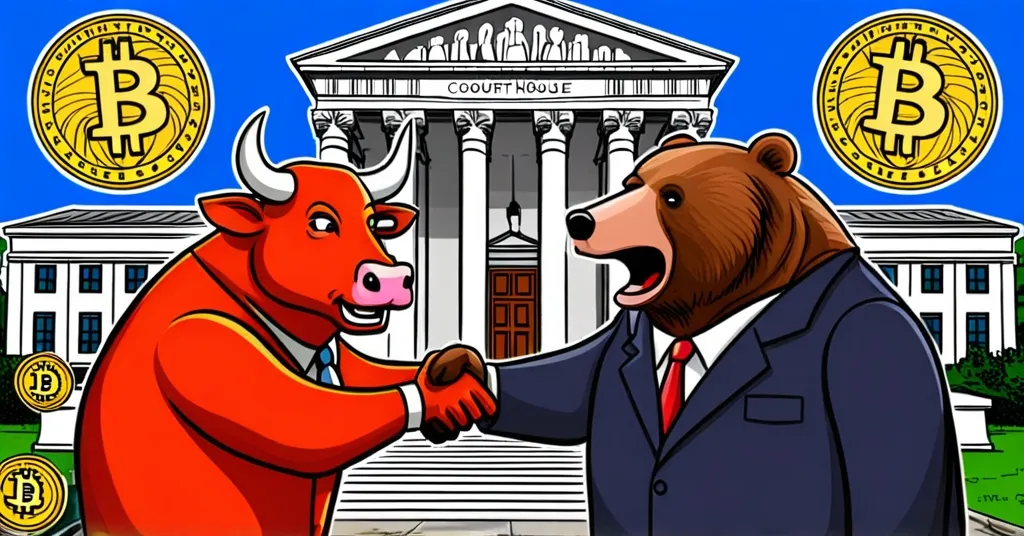SEC and Fed Signal Crypto Thaw, Sparking Market Shifts

SEC Signals a Hands-Off Approach to Crypto
The SEC and Federal Reserve are signaling a more permissive stance towards cryptocurrencies, which could lead to greater integration with traditional finance. Yet, this regulatory shift raises concerns about potential market disruptions and an uptick in illicit activities.
- SEC’s Hester Peirce suggests memecoins fall outside current jurisdiction
- Federal Reserve’s Jerome Powell allows banks to serve crypto businesses
- Robinhood’s earnings soar, driven by digital asset division
In a surprising twist, Hester Peirce, head of the SEC’s Crypto Task Force, recently hinted that many memecoins—cryptocurrencies often inspired by internet memes and known for their speculative nature—might not fall under the SEC’s regulatory umbrella. During her appearance on the Bankless podcast, Peirce stated,
“Many of the memecoins that are out there probably do not have a home in the SEC under our current set of regulations.”
This marks a significant departure from the SEC’s previous enforcement-heavy policies. Peirce’s comments suggest a more hands-off approach to these digital assets, emphasizing that the SEC is actively working to understand its jurisdiction and identify regulatory gaps. She added,
“We’re assessing our jurisdiction, identifying gaps, and pointing them out to Congress.”
This new stance could be a breath of fresh air for crypto enthusiasts, but it also means traders should buckle up for a wild ride without expecting government intervention if things go south.
Simultaneously, Federal Reserve Chair Jerome Powell has signaled a shift in the central bank’s approach to cryptocurrencies. In his testimony to the Senate Banking Committee, Powell declared,
“The Federal Reserve will not block banks from serving legally compliant crypto businesses.”
This move represents a significant change from the Fed’s earlier discouragement of banks engaging with digital asset firms due to concerns over reputation risk. Powell’s comments indicate a more neutral stance, opening the door for banks to explore opportunities in the burgeoning digital asset market. It’s as if the Fed is saying, “Go ahead, dive into the crypto pool, but make sure you’re swimming with the right crowd.”
The impact of this regulatory relaxation is already evident in the financial performance of companies like Robinhood. The trading platform’s Q4 2024 earnings soared above expectations, largely thanks to its digital asset division. Robinhood’s financial statements reveal a staggering 236% increase in transaction-based revenues, jumping from $200 million in Q4 2023 to $672 million in Q4 2024. This surge, with the digital asset division generating over six times the revenue of its equities division, underscores the growing integration of cryptocurrencies with traditional finance. It’s clear that Robinhood is riding the crypto wave like a pro surfer, leaving its equities division in the dust.
While this regulatory shift is a boon for the crypto industry, it’s not all sunshine and rainbows. The relaxation of regulations could lead to traditional banks expanding into digital asset services, potentially shaking up the market dominance of crypto-native firms like Coinbase. Patrick Gerhardt of Telcoin argues that the reputational risk associated with crypto should be reconsidered, as the industry has matured and developed best practices. However, with increased accessibility to digital assets, there’s also a risk of attracting more bad actors, leading to a rise in fraudulent activities and scams. It’s like opening the door to a wild party—you want everyone to have a good time, but you need to keep an eye out for the gatecrashers.
Stephen Gannon of Davis Wright & Tremaine views Powell’s comments as a sign of normalizing crypto integration into the banking system. He stresses the need for concrete actions to follow these statements, indicating cautious optimism about future regulatory developments. The influence of political figures like President Trump on these policy changes cannot be overlooked, as the current administration has campaigned on bringing regulatory clarity to digital assets. It’s a bit like watching a high-stakes poker game—everyone’s waiting to see who will show their cards next.
As the crypto market continues to evolve, these regulatory shifts could have far-reaching implications for consumers, traditional financial institutions, and the overall dynamics of the industry. The potential for increased fraud and market disruption must be carefully managed to ensure the long-term growth and stability of the digital asset ecosystem. It’s a delicate balance between fostering innovation and protecting the public, and the regulators are walking a tightrope.
From a Bitcoin maximalist perspective, these changes could accelerate the adoption of Bitcoin as a safe haven asset amidst the regulatory turbulence affecting other cryptocurrencies. However, altcoins and other blockchain technologies also stand to benefit from this regulatory clarity, filling niches that Bitcoin might not serve well. This aligns with the ethos of effective accelerationism, where the integration of cryptocurrencies into mainstream finance could disrupt the status quo and propel technological advancement.
Key Takeaways and Questions
- What is the current stance of the SEC on memecoins?
The SEC, led by Hester Peirce, has indicated that many memecoins may fall outside its regulatory jurisdiction under current rules.
- How has the Federal Reserve’s approach to banks serving digital asset businesses changed?
The Federal Reserve, under Jerome Powell, has shifted from discouraging banks from engaging with digital asset firms to a neutral stance, allowing banks to serve legally compliant crypto businesses.
- What role has Robinhood’s digital asset division played in its recent earnings?
Robinhood’s digital asset division has been a significant driver of its earnings, generating over six times the revenue of its equities division in Q4 2024.
- What potential market disruptions could arise from this regulatory shift?
The relaxation of regulations might lead to traditional banks expanding into digital asset services, potentially disrupting the market dominance of digital asset-native firms like Coinbase.
- What concerns are raised about the impact of regulatory relaxation on illicit activities?
A more permissive regulatory environment could lead to increased illicit activities, potentially harming consumers and affecting traditional financial institutions entering the market.



